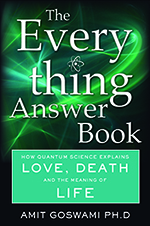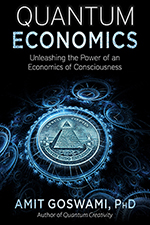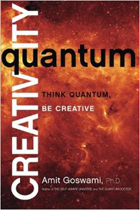God Is Not Dead
By Amit Goswami, Ph.D.
Apart from simplistic and very diverse pictures of God that all religions give for popular appeal, at the esoteric core, all religions agree that apart from material interactions, there is another agent of causation in the world; and this is what they call God. Religions also agree that apart from the material level of reality, which we experience outside of us, there are other subtle levels of reality that we experience when we look inside. Religions also agree about a third very important aspect of divinity: We must try to manifest divine qualities—love, beauty, justice, truth, and good, for example—in our lives.
When not so long ago, the philosopher Nietzsche declared, “God is dead,” he was lamenting that the popular religious renditions of God are so simplistic that they can no longer guide people to move toward Godliness. This is true. Yet to this day, many scientists beat a dead horse by trying to disprove the popular pictures of God. This is beating around the bush and not at all useful. The real questions, and these are all questions of science, are: (1) Is there causation in the world apart from material interactions? (2) Are there subtle non-material levels of reality? And (3) is there any scientific justification of ethics, which compels us to pursue Godliness in our lives?
Most scientists today squarely say “No,” in answer to these questions because they contradict their metaphysics of scientific materialism according to which there is only matter and its interactions, nothing else is real. In my book, God Is Not Dead, I give answers also, and they are all in the affirmative. Yes, there is God. Because (1) there is an agent of causation apart from material interaction; (2) what we experience internally are subtle non-material worlds; and (3) not only should we pursue Godliness in our lives, our evolution is taking us toward better and better manifestations of Godliness. In my book I back up these assertions with both scientific theory and empirical evidence.
Believe it or not, one of the most well known mathematical equations of science proves the existence of God if examined within the new context that we have set. It is called the Schrödinger equation named after one of its discoverers, and it is the fundamental equation of quantum physics. Physicists apply this equation for the study of many objects and many events; under these circumstances, the equation predicts (statistically) deterministic results and so most physicists miss God in the equation. The right question to ask is how does this equation apply to a single object in a single event, as it must?
You see, the problem is that the Schrödinger equation depicts objects not as “determined things” of Newtonian vintage but as waves of possibility for consciousness to choose from? How do we know this? Because whenever we look at a quantum object, an electron for example, we don’t see possibilities—an electron in different places all at once—but an electron in one actual place, an actuality. So we must be choosing where the electron actualizes!
Let’s go deeper. If we (our consciousness) are able to convert possibility into actuality, our consciousness cannot be a brain product or any other material object since all material objects obey quantum physics and must be possibilities only. So consciousness as a nonmaterial agent of choice is a causal agent! Have we discovered God?
No, say the scientists, and they are right up to a point. The above raises the paradox of dualism if we think of the choosing consciousness or God, an agent separate from us, as popular religions do. To see this, ask the simple question, how does a nonmaterial God interact with the material world? It can’t without a mediator. But a mediator signal requires energy. And the energy of the physical world is a constant; energy never passes from the material world to a God world and vice versa.
In the esoteric core, the masters of the various religions understood the situation perfectly. God is not separate from the material world, they declare at various places, times, and cultures. God is both transcendent and immanent. But what do they mean? Until recently, scientists and ordinary people alike, have not been able to penetrate the wisdom of these words. So scientists ignore them and ordinary people go on thinking about God as a dual agent of causation. Proper understanding of quantum physics resolves the logjam.
The quantum concept that is truly radical and that is changing our world view is called nonlocality—signal less interaction. Matter consists of waves of possibility within consciousness, which is the ground of all being. Consciousness chooses one facet out of the multifaceted quantum possibility wave and converts possibility into the actuality of that chosen facet, but there is no dualism because consciousness does the choosing nonlocally without signal. It is choosing from itself.
Is it like Waiting for Godot: We have been looking for God and it is us? It is each of us who chooses his or her own reality. Alas! This, too, is too simplistic, which is why your wishful thinking about manifesting a BMW for yourself does not usually work.
There is a paradox here. Suppose you and your friend are approaching from perpendicular directions a “quantum” traffic light with two possible facets, red and green. Being busy people, you both want green, but who gets to choose? If you both get to choose, obviously there would be pandemonium. Or perhaps you are like the Hollywood woman who meets a friend on Sunset Boulevard and takes her to a coffee house to “catch up.” Over coffee, she starts talking and after an hour says, “Oh my God, I have been talking about myself all this time. Let’s now talk about you. What do you think of me?” To this woman, the only consciousness in the world is hers, and she is always the chooser. Such people are called solipsistic.
But solipsism is obviously not the answer to our paradox. It has shifted the question, “Who gets to choose?” to, “Who gets to be the solipsistic head honcho of the situation? No more than that. The paradox remains.
The authentic solution is this: The choosing nonlocal consciousness is not us in our ordinary ego, but a “transcendent” consciousness that is both us and beyond us, both transcendent and immanent.
Makes sense, doesn’t it? And more. This nonlocality of our choosing consciousness is an experimentally verifiable idea. In fact, this nonlocality has been verified by five different experiments by five different groups at five different laboratories all showing the direct transfer (without signals) of electrical activity from one subject’s brain to another when the subjects are correlated through meditative intention. This is reported in God Is Not Dead.
So the scientific evidence for God and God’s causal efficacy is already here. The evidence is definitive because nonlocality can never be simulated by material interactions that always occur via the intermediary of signals.
This is not the only evidence. God’s choice is creative and manifests in our creative experience through discontinuous quantum leaps akin to electron’s leap from one atomic orbit to another without going through the intervening space. Creative experiences are subjective, you say. Not when such leaps heal a person from a life threatening disease, a phenomenon called quantum healing for which plenty of evidence exists.
Objective evidence for such creative quantum leaps also show up in biological evolution and explains the puzzling phenomena of the fossil gaps (or missing links) which Darwinism cannot explain.
How about subtle bodies? If matter consists of waves of possibility for consciousness to choose from and conscious choice leads to our experience of sensing, then it makes sense to posit that our internal experiences are also due to conscious choice from subtle domains of quantum possibilities. As the psychologist Carl Jung first codified, we have four kinds of experiences: sensing, feeling, thinking, and intuiting. In this way there must be four different compartments of conscious possibilities; the physical we sense, the vital energies we feel, the mental meaning we think, and the supramental archetypes—love etc.—we intuit.
The empirical evidence for subtle bodies abound in health and healing, in dreams, in the phenomenon of biological morphogenesis, in survival after death and reincarnation, just to name a few.
Again, scientific evidence for God is already here, so what should we do about it? For one thing, we should take the religious masters seriously and pay attention to ethics. The values—love, beauty, justice, truth, and goodness—that ethics talk about are what we intuit. And plenty of evidence exists (for example, in the phenomena of dreams, creativity, and reincarnation) for the importance and validity of ethics as discussed in God Is Not Dead.
And more. When we recognize that Darwin’s theory of continuous evolution is incomplete and complement it with the creative discontinuous quantum leaps, we discover an astounding thing. Biological evolution’s direction from simple to complex organisms can be explained. We evolve from simplicity to complexity to be able to manifest our experiences of the subtle domains of possibilities better and better. In particular, right now we are evolving toward manifesting better and better Godly qualities.
Someday, said the Jesuit philosopher Teilhard de Chardin, we shall harness . . . the energies of love.” Teilhard was right. That day is not very far away.
In his private life, Goswami is a practitioner of spirituality and transformation. His forth coming book, The Everything Answer Book: How Quantum Science Explains Love, Death and the Meaning of Life will be published by Hampton Roads Publishing Company in April 2017.



